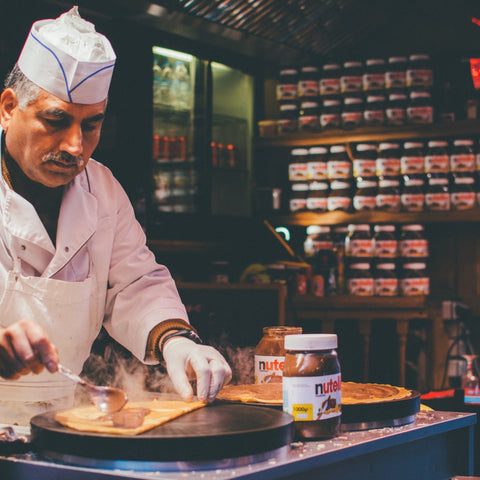How can I make crêpes like the crêperies in France?
If you want a recipe to make your own authentic tasting crêpes like the crêpe stalls on the streets of Paris, you will need to start with a good quality plain flour, ideally French in origin and with a mineral content of T45 or T55.
To ensure good texture add a small portion of buckwheat flour; this will give your crêpes a slightly nutty flavour and ensure your crêpes are perfect for both sweet and savoury fillings.
Use the best free range organic eggs you can get you hands on, and preferably a good quality French unsalted butter.
A traditional copper crêpe pan is the best cooking utensil for making crêpes at home but any non-stick frying pan will be fine, ideally about 20cm diameter.
If you are using a crêpe machine then you will probably be making larger crêpes and will need a thicker batter - otherwise your crêpes will tear when you come to flip them! Add about 25g more flour than in the recipe below.
A busy professional crêperie chef will need to keep his cast-iron plates nice and hot so his customers aren’t waiting too long, and so to ensure that none of the crêpes stick and tear he will typically use a very thin film of grape-seed oil on the hotplates between crêpes; we always use this since it has little flavour or odour to affect the taste of the crêpe.
But if you want a really indulgent crêpe (and who doesn’t?) use butter to oil your pan/crêpe machine between crêpes - heat on a medium setting until the butter sizzles and then spread to cover the whole surface with a thin layer of the melted butter.
TRADITIONAL RECIPE FOR CREPES - TO SERVE TWO
INGREDIENTS
100g plain flour
25g buckwheat flour
2 large eggs
1/4 teaspoon Sea Salt
300ml whole milk
30g butter (plus more for frying)
Pinch of nutmeg
METHOD
- Melt the butter in a saucepan and let it cool a little
- Whisk together the flour, buckwheat flour, milk, salt, nutmeg and eggs, then stir in the melted butter. Leave to stand at room temperature for 30 minutes.
- Heat your crêpe pan and melt some butter in it to season it, then wipe it all off. Ladle 2–3 tablespoons of batter into the pan then quickly hold it up and swirl so that the batter forms a quick, thin pancake covering the base of the pan. Cook until the edges start to come away from the pan and become golden and crispy, then flip it and cook for a further minute or so on the other side until it’s cooked through, then remove the crêpe onto a layer of baking paper.
- Continue with the next crêpe, and once you have a rhythm keep going until all the batter is gone.
You can ‘rack and stack’ the crêpes; this is great for sweet crêpes and if you are making them for several guests. Layer them one on top of the other until all the batter is gone and then place the pile in the centre of the dining table. Your guests can peel the crêpes off as required onto their pre-warmed plates for them to fill as they like.
Alternatively you can fill your crêpes as you make them - this is ideal if you are making savoury crêpes so the fillings can warm as the crêpe cooks.
Crêpes, ready filled or empty, reheat very well in a microwave.
Spoiler alert; most busy crêperies will actually be using a good quality ready-made mix because they need the batter to be quick and easy to make - then they can concentrate on giving you the exciting combination of fillings you want!



Leave a comment